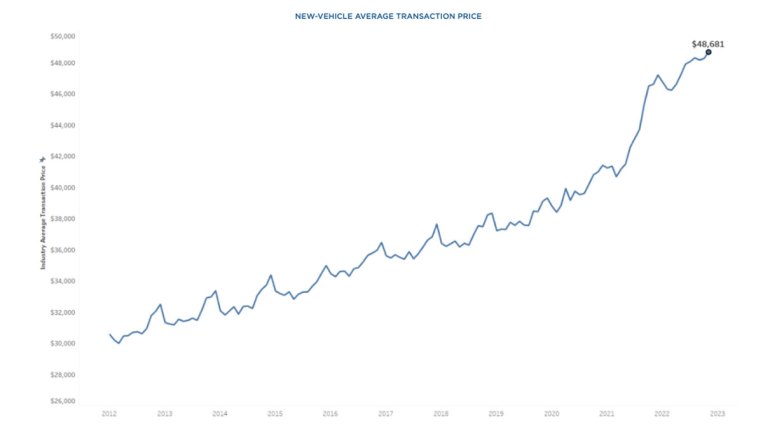Quick Facts About Car Prices
While finding a new car today can be tricky, striking a good deal is tougher. It’s a seller’s market. In other words, even the fairest dealers don’t have an incentive to dicker, so be prepared to pay sticker.
With that bit of folksy poetry fixed in your mind, you’ll need to guard against any dealers treating today’s short supply of cars like a winning lottery ticket. Many are tacking thousands of dollars in dealer markups to the manufacturer’s suggested retail price (MSRP). By law, window stickers on every new car available for sale must display the MSRP.
With dealer lots looking empty, many vehicles arriving on transport trucks will often be presold or at least promised. It’s a difficult market for car shoppers.
In this article, we’ll explain markups and market adjustments, why dealers started marking up the prices of new vehicles beyond MSRP, and what, if anything, you can do about it.
What’s Supply Got To Do With It?
If you start shopping for a new car, you may encounter dealers who refuse to budge from the vehicle’s posted window sticker price. In other words, they aren’t willing to negotiate.
New car inventories remain exceedingly tight due to the chip shortage, supply-chain disruptions, and other factors. Many of today’s popular features, like touchscreens, navigation, and power-adjustable seats, require microchips.
According to data from Kelley Blue Book’s parent company Cox Automotive, new car prices neared an all-time high of $48,681 for November 2022. That’s a 4.4% increase from the same month a year earlier. It’s the 18th straight month car buyers paid more than MSRP.

The current new vehicle inventory was 1.64 million units, or 53 days of supply at the end of November 2022. That sounds like a lot, but it’s historically low. Before the pandemic, dealerships kept 3.49 million cars in stock, or an 86-day supply of vehicles for consumers to buy.
Every car a dealer sells today will be unavailable to sell tomorrow. That’s always the case. However, dealers today can sell only a handful of vehicles on-site, with potential buyers lined up like it’s an opening day for a highly popular movie.
Car Prices Determined by Supply and Demand
If you never pay much attention to the fundamental theories of economics, you may not realize the current marketplace works like a Petrie dish for the effects of supply and demand. In an open market, the price gets determined by demand. The more of a thing people want (like cars), the more they are willing to pay for them, and the higher their price. That higher price motivates additional production of that thing, and the price eventually falls.
Car dealers do not exist in business to break even. When you find your dream car and the dealer wants the full MSRP — or more — you can always walk away. Waiting for that dealer to come back with a better offer probably isn’t the best use of your time. If it’s a popular model and you wait, someone else might snatch it up.
These days, a dealer demanding the full MSRP isn’t cheating you. You’re paying the manufacturer’s assigned price to that car. In this economy, it’s probably a good deal.
Brands with the deepest inventory may have dealers more inclined to negotiate or stick with the MSRP.
Brands with the Most Inventory
- Buick
- Jeep
- Infiniti
- Dodge
- Ram
- Jaguar
- Volvo
- Lincoln
- Chrysler
- Audi
Brands with Low Inventory
According to Cox analysis of vAuto available inventory data, the brands with the lowest inventories include:
- Toyota
- Kia
- Lexus
- Land Rover
- Honda
- BMW
- Subaru
- Volkswagen
- Acura
- Hyundai
If you’re shopping for a minivan or a hybrid, expect to face a tough time finding those. Also in high-demand are compact, subcompact, and midsize cars due to fuel efficiency. But you’ll be in luck if you want to buy a large or luxury subcompact SUV or a full-size pickup truck from a domestic automaker (excluding the Ford F-150 Lightning). There’s more in stock of those types of vehicles.
On average, Honda and Kia buyers paid between 6% to 8% over sticker price in November. Meanwhile, Buick showed the least price strength, selling 2% or more below MSRP in November.
RELATED: When Will New Car Prices Drop?
What Is Dealer Markup?
For our purposes here, we define dealer markup as profit and a selling price the dealership assigns that is above and beyond the carmaker’s MSRP. A dealer tacks these arbitrary amounts onto the MSRP to increase profit on high-demand models. Sometimes such markups appear as a second window sticker separate from the MSRP.
Historically, you would find them primarily for highly anticipated all-new or redesigned models. Dealer markup may show up under the following terms listed on the label and on your sales invoice:
- Market adjustment
- Additional dealer markup (ADM)
- Additional dealer profit (ADP)
- Adjusted market value
These costs are the ones to look out for and, if possible, avoid.
Other markups you might encounter include the cost of dealer add-ons like delivery fees, ceramic coating, seat-fabric protection, VIN etching, and pin stripping. You could often negotiate such traditional add-ons out of the final transaction price. Even that is tougher to do today.
Manufacturers Warn Dealers About Markups
High demand gets spread across nearly all vehicle makes and models in today’s market. The temptation to price gouge is simply too great for some dealers to resist.
In 2022, manufacturers like Ford, General Motors, Subaru, Hyundai, and others began cracking down on dealership pricing.
Crowdsourced website Markups.org reveals just how drastic the price increases look, offering specifics on dealerships and providing, in some cases, visuals to go along with the markup information. Although a solid number of vehicles don’t show any dealer markups, many others do. We found one as high as $40,000 that an Illinois Ford dealer tacked on a new electric 2022 Ford F-150 Lightning.
Ford’s CEO Jim Farley has warned dealers to “cut” the markups during company earnings calls. Also, Farley wants the company to move to a new business model of non-negotiated prices and 100% online.
Hyundai sent warning letters to dealers and mentioned specific practices, including:
- Advertising one price online, then naming a different price when the customer starts negotiating.
- Affixing window stickers with markups included as itemized parts of a vehicle’s price.
“All of these practices result in the sale of vehicles for above-MSRP prices, in some cases way above-MSRP prices,” the letter said, according to a report on Automotive DriftBreath. That risks “damaging our brands’ long-term ability to capture new customers and retain loyal ones.”
What You Can Do About High Markups on Cars
- Wait: Although new car inventories will remain tight throughout 2022 and into 2023, this market won’t last forever. If you aren’t desperate for a new car, wait for more favorable times.
- Contact several dealers: The more dealers you contact, the better your chance of scoring the best deal. To simplify the process, use our tool to obtain a free price quote from dealers in your local area. You can choose from a list and decide who contacts you with quotes.
- Be prepared to compromise: The Rolling Stones said it best — “You don’t always get what you want.” If you are going to buy off a dealer’s lot or from those coming in on a truck, remain flexible. The odds are you won’t get exactly the color you want, with the engine you want, or with the accessories you want. Decide what is most important and be willing to compromise on everything else.
- Don’t take dealer ads at face value: New car advertising typically comes with many disclaimers and caveats regardless of the market conditions. If a new car price seems too good to be true, it probably is. When you see a specific model advertised, call the dealer and make sure it’s there before making the trip. When an ad claims they have several units of the same model on hand, don’t count on it. Often those numbers include vehicles that have yet to arrive, are already spoken for, or are sold.
- Consider ordering from the factory: Except for some electric brands like Tesla and Rivian, most carmakers still require you to order a vehicle through a franchised dealership. However, you can specify precisely the color, model, and options you want when you order the car. You will probably still pay MSRP or maybe even a little more. But at least you’ll have the exact vehicle you want. The issue with special ordering is that the car may take many months to arrive.
- If leasing, watch for fees. Many leases contain a vague list of fees and costs related to the upfront charges and picking the purchase option when returning a lease. Check your lease contract and know your rights. Some dealers started charging market adjustment fees on leases. Question everything, shop around for the best deal, and don’t pay anything not listed in the contract.
Editor’s Note: This article has been updated for accuracy since it was originally published.
Read Related Articles:


